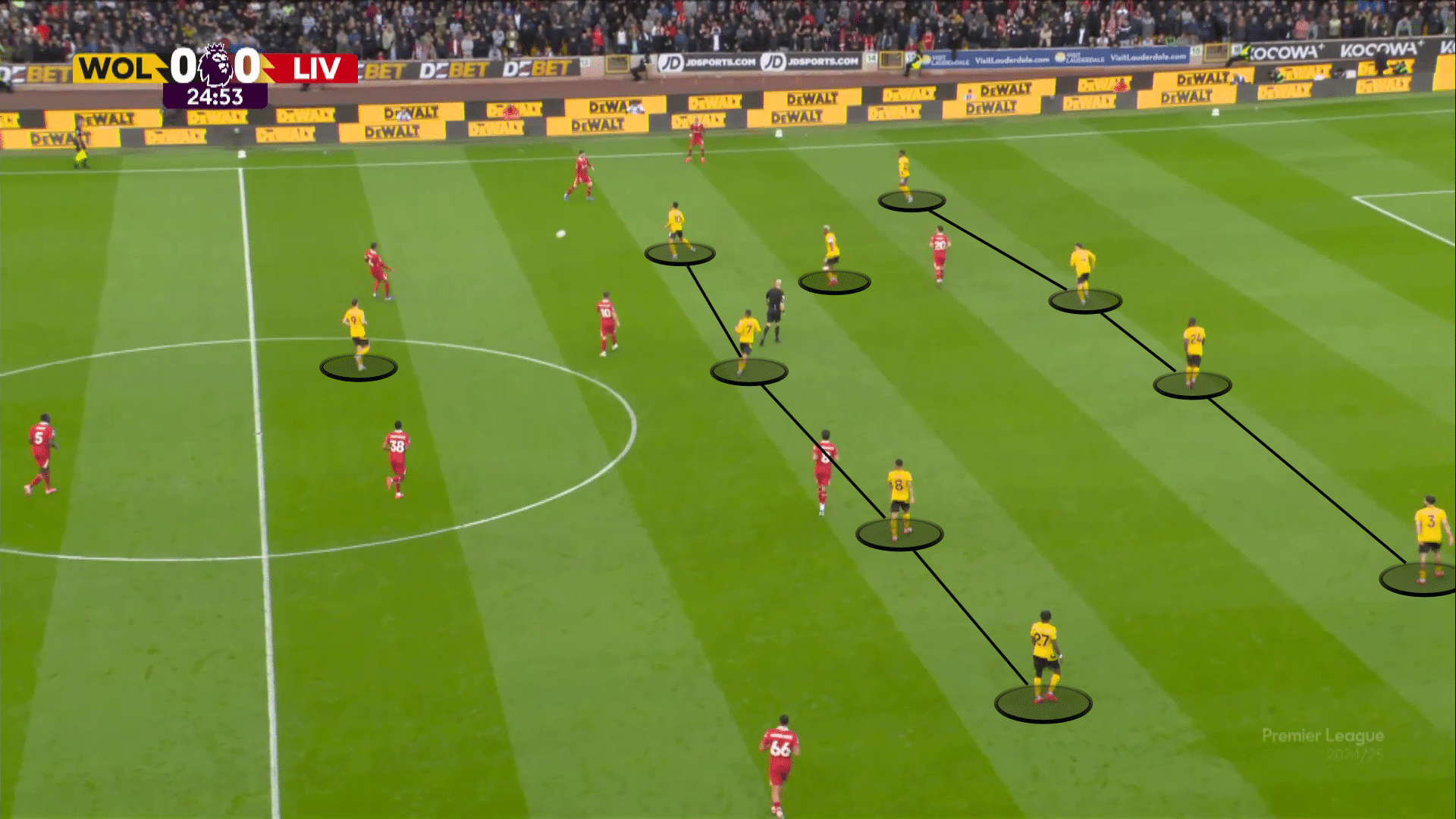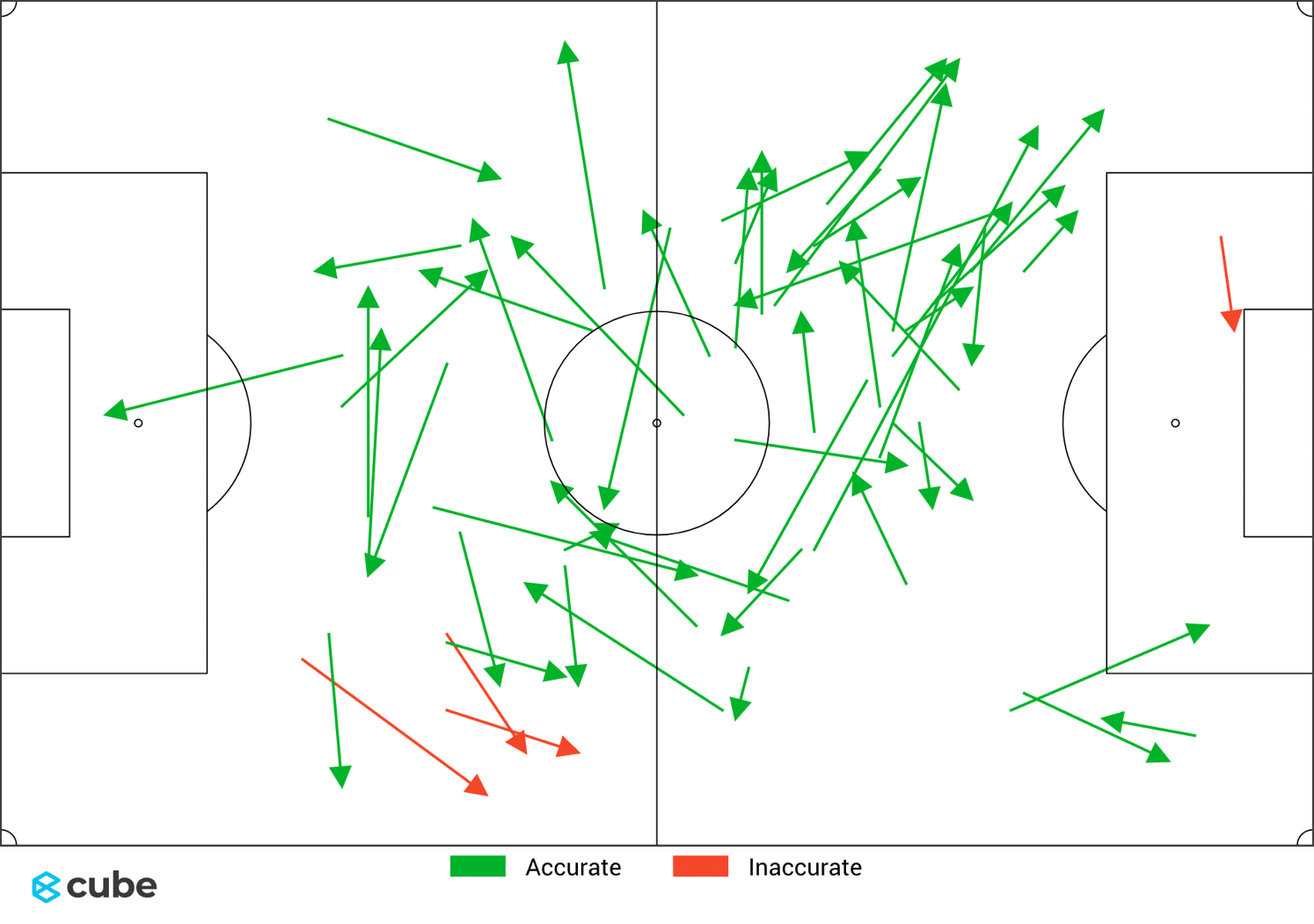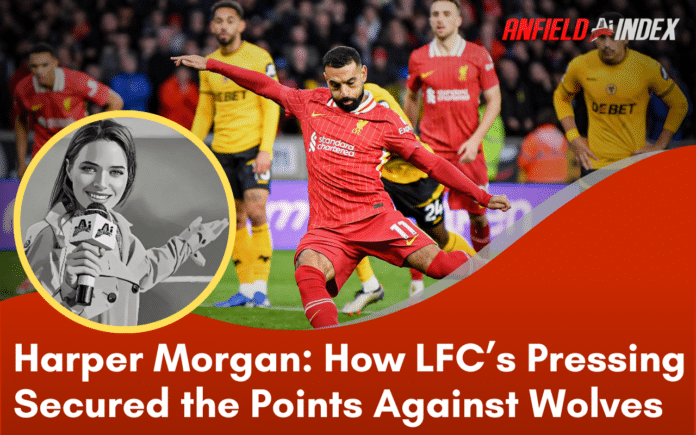Wolves 1-2 Liverpool: Tactical Analysis with xfb Analytics
Saturday evenings usually find me comfortably settled in front of the telly, indulging in my weekly dose of Strictly Come Dancing followed by The Voice UK. My Chinese takeaway and a glass of red in hand, it’s a fine routine, but this past Saturday, Liverpool’s clash with Wolves meant that Strictly had to wait—catch-up TV until after 2AM it was. And, like my evening routine, Liverpool’s performance didn’t quite flow seamlessly either, but they managed to walk away with the three points.
Wolves Compact Shape and Liverpool’s Struggles
Arne Slot’s post-match words perfectly captured the essence of the night: “It was not our best performance, maybe, but a good result.” Liverpool may have secured the win, but this was far from their most scintillating display. Wolves, under the guidance of Gary O’Neil, set up in a disciplined 4-1-4-1 or 4-2-3-1 mid-block when out of possession, making life incredibly difficult for Liverpool. As the tactical visualisations from @borbely_imre and xfb Analytics show, Wolves were compact, with Mario Lemina sitting just in front of their four-man defence, obstructing passing lanes, particularly to Diogo Jota.


The real challenge for Liverpool was the short distances between Wolves’ lines. There was very little space to exploit, and with their own rhythm far too sluggish, the Reds struggled to carve out high-quality chances. One notable exception came when Virgil van Dijk played a superb pass out to Andrew Robertson, who then whipped in a delightful cross for Dominik Szoboszlai. The Hungarian’s header generated an xG of 0.75, but Wolves’ keeper Sam Johnstone produced a stunning save to keep the score level.

Liverpool’s Lack of Fluency In Attack
Liverpool’s passing accuracy, particularly in the first half, was notably subpar. Slot’s team managed just 85% accuracy—a sign that they weren’t clicking as they usually do. Wolves, on the other hand, were physically imposing, winning 58% of their duels. When it came to ground duels, the contrast was even starker, with Wolves dominating 61%-31%.
While Liverpool struggled to find their attacking fluency, they were much sharper defensively. Slot’s 4-2-4 shape when out of possession proved effective in frustrating Wolves’ build-up play. By funnelling Wolves’ attacks out wide, Liverpool were able to control their opposition’s efforts and prevent them from progressing centrally.

Despite their lacklustre build-up, Liverpool’s pressing game was on point. They registered a remarkable 81 recoveries to Wolves’ 61, with 15 coming in the opponent’s half. These high recoveries—many of which occurred on the left side—allowed Liverpool to launch dangerous counter-attacks.


Gravenberch and Mac Allister Shine in Liverpool’s Midfield
Even in a game where Liverpool weren’t at their best, there were standout performances. Ryan Gravenberch, in particular, continued his stellar form as Liverpool’s new No. 6. His distribution was impeccable, completing 55 of 59 passes (93% accuracy). The Dutchman was also tenacious off the ball, contributing three tackles—the most of any player on the pitch. His 73 touches, five recoveries, and seven ground duels won underscored just how influential he was. Add to that the fact he was fouled four times, and it’s clear he was a constant thorn in Wolves’ side.

Alexis Mac Allister also deserves significant credit for his tireless defensive work. He was Liverpool’s most active player without the ball, constantly breaking up Wolves’ play through interceptions, tackles, and recoveries. Meanwhile, Jota and Ibrahima Konaté put in similarly diligent shifts, demonstrating Liverpool’s commitment to the defensive side of their game.
Liverpool’s Off-Ball Mastery
Liverpool’s off-the-ball movements were a masterclass in control, even when their on-the-ball play lacked sparkle. Their proactive pressing and smart positioning made it tough for Wolves to create any meaningful chances from open play. While Liverpool’s attacking endeavours didn’t flow as freely as we’ve come to expect, their tactical discipline helped keep the game in their favour.
The numbers back this up. Liverpool created more shots than Wolves (10 to 8), more shots on target (6 to 3), and generated higher xG from open play (1.49 to 0.58). Most strikingly, they managed 38 touches inside Wolves’ penalty area compared to Wolves’ 18. It wasn’t the free-flowing football that usually gets you off the couch—much like skipping Strictly on a Saturday—but it got the job done.
Promising Start For Slot’s Liverpool
As frustrating as the game may have been, there’s no denying that Liverpool deserved the win. Their superior quality shone through in key moments, and while it wasn’t a vintage performance, the result adds to what has been a fantastic start to the season for Arne Slot’s side.

Liverpool currently boast the best xG per 90 minutes in the Premier League (2.08), and defensively, they’re just as impressive, conceding only 0.74 xGA per 90 minutes—the lowest in the league. With just two goals conceded so far and a goal difference of +10, Slot’s Liverpool have taken 15 points from a possible 18. If this is them not firing on all cylinders, just imagine what they’ll look like when they’re fully in sync.
As I finally got to catch up on Strictly in the early hours of Sunday morning, there was a sense of relief that, while Liverpool might have disrupted my Saturday evening, they’re showing all the right signs of something special this season. Just as my weekend routine may have changed, it seems Liverpool are in the process of evolving too—and the best may still be yet to come.




